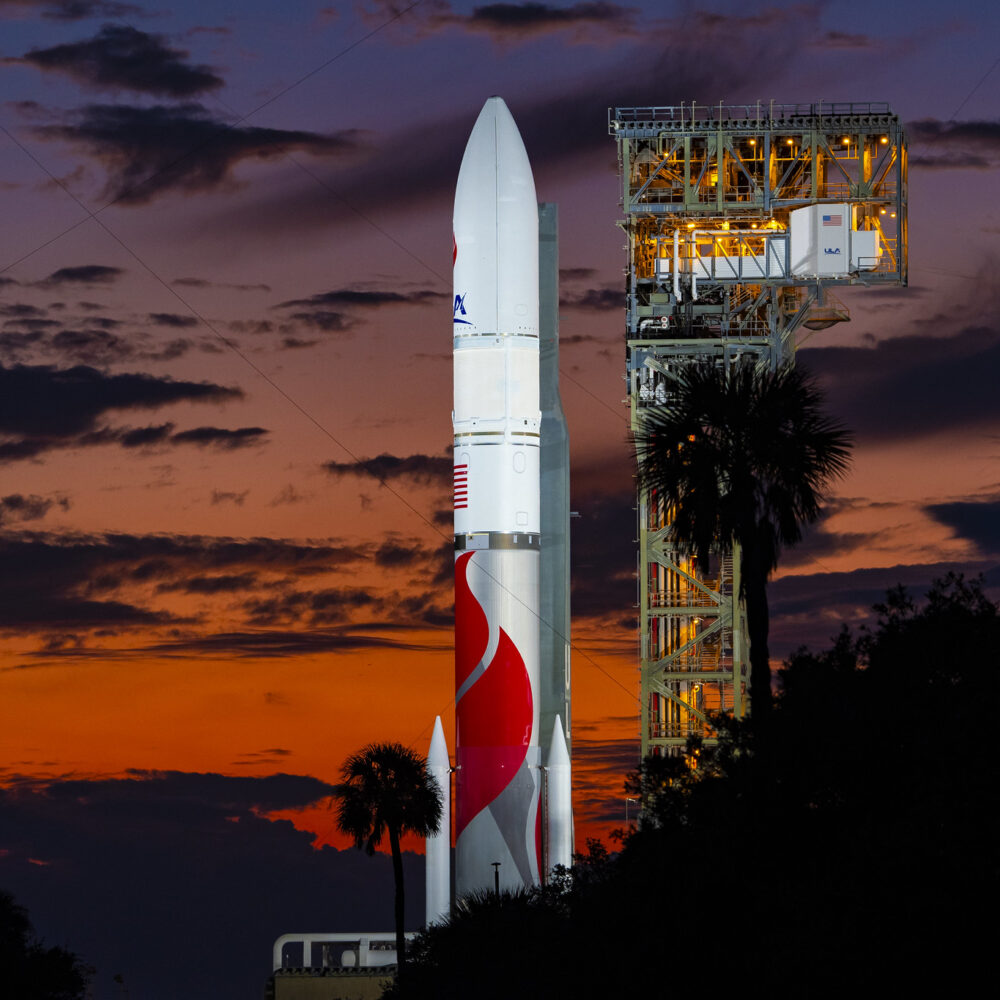"I’m pretty darn confident I’m going to have a good day on Friday."

United Launch Alliance's Vulcan rocket sits on the pad at Space Launch Complex-41 (at Cape Canaveral at sunset in advance of the Cert-2 flight test. Credit: United Launch Alliance
Welcome to Edition 7.14 of the Rocket Report! For readers who don't know, my second book was published last week. It's titled Reentry, and tells the story behind the story of SpaceX's development of the Falcon 9 rocket and Dragon spacecraft. The early reviews are great, and it made USA Today's bestseller list this week. If you're interested in rockets, and since you're reading this newsletter we already know the answer to that, the book is probably up your alley.
As always, we welcome reader submissions, and if you don't want to miss an issue, please subscribe using the box below (the form will not appear on AMP-enabled versions of the site). Each report will include information on small-, medium-, and heavy-lift rockets as well as a quick look ahead at the next three launches on the calendar.

Vega C cleared for next launch in November. Italian rocket firm Avio successfully tested a redesigned Zefiro-40 solid rocket motor for the second time on Thursday, the European Space Agency said. This second firing follows an initial firing test of the motor in May 2024 and concludes the qualification tests for the new engine nozzle design of the Zefiro-40. This rocket motor powers the second stage of the Vega C rocket.
Flight three almost ready ... The redesign of the motor was necessitated by the failure of a Vega C rocket in December 2022, which was just the second flight of the launch vehicle. Then, in June 2023, a test to re-certify the motor for flight also failed. Now that the second-stage issue appears to be resolved, Vega C is on the launch calendar for November of this year, although there's the possibility the third mission of the rocket could slip a bit further. The rocket will be carrying the Sentinel-1C satellite to Sun-synchronous orbit. (submitted by EllPeaTea and Ken the Bin)
Impulse Space raises $150 million. Los Angeles-based space startup Impulse Space, which is led by renowned rocket scientist Tom Mueller, has raised $150 million in a new fundraising round led by venture capital firm Founders Fund, CNBC reports. Impulse is scaling a product line of orbital transfer vehicles, and so far is building two, the smaller Mira and the larger Helios. While rockets get satellites and payloads into orbit, like an airplane carrying passengers to a metro area, space tugs deliver them to specific destinations, like taxis taking those passengers home from the airport.
Taking the next step after launch ... Mueller, who founded Impulse Space three years ago, said the funds will fuel growth of the company. "This means that we’re sufficiently funded through the development of Helios and the upgraded version Mira and out past the first flights of both of these products," Mueller told the publication. Impulse flew its first mission, called LEO Express-1, with a Mira vehicle carrying and deploying a small satellite, last November. In Mueller’s view, while SpaceX reduced the cost to launch mass to orbit, the in-space delivery systems on the market are lacking. (submitted by Tom Nelson and Ken the Bin)
The easiest way to keep up with Eric Berger's space reporting is to sign up for his newsletter, we'll collect his stories in your inbox.
Polish company receives ESA support. Did you know there is a launch startup in Poland? Until this week, I confess I did not. However, that changed when the European Space Agency awarded 2.4 million euros to Poland’s SpaceForest for further development of its Perun rocket. SpaceForest has developed an 11.5-meter-tall sounding rocket capable of carrying payloads of up to 50 kilograms to an altitude of 150 kilometers, European Spaceflight reports.
Boosting up commercial companies ... To date, the company has completed two test flights, one reaching an altitude of 22 kilometers and another topping out at 13 kilometers. With the new funding from ESA, SpaceForest will implement upgrades to the combustion chamber of its in-house developed SF1000 paraffin-powered hybrid rocket engine. ESA awarded the funding as part of the agency’s Boost! initiative. Adopted by member states in 2019, Boost! aims to foster the development of new commercial space transportation services. (submitted by Ken the Bin and EllPeaTea)
A new take on a kinetic launch system. Longshot Space is developing a straight-line kinetic launch system that will gradually accelerate payloads to hypersonic speeds before launching them to orbit, TechCrunch reports. The startup is betting it can achieve very, very low costs to orbit compared to a rocket, possibly as low as $10 per kilogram. The company raised $1.5 million in a pre-seed round in April 2023 and now, nearly 18 months later, Longshot closed a little over $5 million in combined venture capital and funding from the US Air Force’s TACFI program.
Pulling some serious Gs ... The new capital will be used to build a large, 500-meter-long gun in the Nevada desert to push 100-kilogram payloads to Mach 5. The system has to be so long in order to keep acceleration forces low, which is better for both the vehicle and payload. For eventual space missions, Longshot is aiming to keep the maximum gravitational forces to 500–600 times the force of gravity. The company's name serves a dual purpose, as its technology requires a longshot to reach space, and its prospects for success are probably a longshot. Nevertheless, it's great to see someone trying new ideas. (submitted by Ken the Bin)

Falcon 9 rocket upper stage misfires. SpaceX is investigating a problem with the Falcon 9 rocket's upper stage that caused it to reenter the atmosphere and fall into the sea outside of its intended disposal area after a launch last Saturday with a two-person crew heading to the International Space Station, Ars reports. The upper stage malfunction occurred after the Falcon 9 successfully deployed SpaceX's Crew Dragon spacecraft carrying NASA astronaut Nick Hague and Russian cosmonaut Aleksandr Gorbunov on SpaceX's Crew-9 mission. Hague and Gorbunov safely arrived at the space station Sunday to begin a five-month stay at the orbiting research complex.
Returning to flight shortly? ... Safety warnings issued to mariners and pilots before the launch indicated the Falcon 9's upper stage was supposed to fall somewhere in a narrow band stretching from southwest to northeast in the South Pacific east of New Zealand. Most of the rocket was expected to burn up during reentry, but SpaceX targeted a remote part of the ocean for disposal because some debris was likely to survive and reach the sea. This is the third time SpaceX has grounded the Falcon 9 rocket in less than three months, ending a remarkable run of flawless launches. A return to flight is expected as early as October 7 with the European Space Agency's Hera spacecraft.
New Zealand seeks to reduce rocket regulations. New Zealand plans to implement a new "red tape-cutting" strategy for space and aviation by the end of 2025, the New Zealand Herald reports. "We have committed to having a world-class regulatory environment by the end of 2025," Space Minister Judith Collins told the NZ Aerospace Summit recently. "To do that we're introducing a light-touch regulatory approach that will significantly free up innovators to test their technology and ideas."
Kiwis have a different attitude ... The goal of reducing regulations is to allow companies to focus more on innovation and less on paperwork. New Zealand officials are motivated by concerns that Australia may seek to lure some of its space and aviation industries. Among the space companies with a significant presence in New Zealand are Rocket Lab, Dawn Aerospace, as well as smaller firms such as Astrix Astronautics. The move comes as US-based firms such as SpaceX, Varda, and others are pushing the country's launch regulator, the Federal Aviation Administration, to be more nimble.
H2A nears the end of the road. Japan launched the classified IGS-Radar 8 satellite early Thursday with the second-to-last H-2A rocket, Space News reports. Developed and operated by Mitsubishi Heavy Industries, the H-2A rocket debuted in 2001 and has flown 49 times with a single failure, suffered in 2003. It has been a reliable medium-lift launch vehicle for Japan's national space interests, as well as a handful of commercial space customers.
The rocket’s 50th launch will be its last ... The final H-2A core stage is now completed and is scheduled for shipment to the Tanegashima Space Center. That launch, expected in late 2024, will carry the Global Observing SATellite for Greenhouse gases and Water cycle satellite. The H3 will succeed the H-2A. The new generation H3 had a troubled start, with its first flight in March 2023 suffering a second-stage engine failure. However, the new rocket has since flown successfully twice. (submitted by Ken the Bin)
Russians can invest in SpaceX now? Da. One of the odder stories this week concerns a Russian broker apparently offering access to privately held shares of SpaceX. An article in the Russian newspaper Kommersant suggests that a Moscow-based financial services company, Finam Holdings, managed to purchase a number of shares from a large foreign investment fund. The article says the minimum investment for Russians interested in buying into SpaceX is $10,000.
On bonds and broomsticks ... Honestly, I have no idea about the legality of all this, but it sure smells funny. SpaceX, of course, periodically sells shares of the privately held company to investors. In addition, employees who receive shares in the company can sometimes sell their holdings. Given the existing sanctions on Russia due to the war on Ukraine and the potential for additional sanctions, it seems like these shareholders are definitely taking some risk.

ULA chief "supremely confident" in Vulcan's second launch. The second flight of United Launch Alliance's Vulcan rocket, planned for Friday morning, has a primary goal of validating the launcher's reliability for delivering critical US military satellites to orbit. Tory Bruno, ULA's chief executive, told reporters Wednesday that he is "supremely confident" the Vulcan rocket will succeed in accomplishing that objective, Ars reports. “As I come up on Cert-2, I’m pretty darn confident I’m going to have a good day on Friday, knock on wood," Bruno said. "These are very powerful, complicated machines."
A lengthy manifest to fly ... The Vulcan launcher, a replacement for ULA's Atlas V and Delta IV rockets, is on contract to haul the majority of the US military's most expensive national security satellites into orbit over the next several years. If Friday's test flight goes well, ULA is on track to launch at least one—and perhaps two—operational missions for the Space Force by the end of this year. The Space Force has already booked 25 launches on ULA's Vulcan rocket for military payloads and spy satellites for the National Reconnaissance Office. Including the launch Friday, ULA has 70 Vulcan rockets in its backlog, mostly for the Space Force, the NRO, and Amazon's Kuiper satellite broadband network.
NASA's mobile launcher is on the move. NASA's Exploration Ground Systems Program at Kennedy Space Center in Florida began moving the mobile launcher 1 from Launch Complex 39B along a 4.2-mile stretch back to the Vehicle Assembly Building this week. First motion of the mobile launcher, atop NASA’s crawler-transporter 2, occurred early on the morning of October 3, the space agency confirmed. Teams rolled the mobile launcher out to Kennedy’s Pad 39B in August 2023 for upgrades and a series of ground demonstration tests in preparation for the Artemis II mission.
Stacking operations when? ... After arriving outside the Vehicle Assembly Building later on Thursday, the launch tower will be moved into High Bay 3 on Friday. This is all in preparation for stacking the Space Launch System rocket for the Artemis II mission, which is nominally scheduled for September 2025 but may slip further. NASA has not publicly said when stacking operations will begin, and this depends on when the space agency makes a final decision on whether to fly the Orion spacecraft with its heat shield as-is or adopt a different plan. Stacking will take several months.
Next three launches
Oct. 4: Vulcan | Cert-2 mission | Cape Canaveral Space Force Station, Florida | 10:00 UTC
Oct. 7: Falcon 9 | Hera | Cape Canaveral Space Force Station, Florida | 14:52 UTC
Oct. 9: Falcon 9 | OneWeb-20 | Vandenberg Space Force Base, California | 06:03 UTC

Eric Berger is the senior space editor at Ars Technica, covering everything from astronomy to private space to NASA policy, and author of two books: Liftoff, about the rise of SpaceX; and Reentry, on the development of the Falcon 9 rocket and Dragon. A certified meteorologist, Eric lives in Houston.





:quality(85):upscale()/2024/10/29/625/n/1922564/ec222ac66720ea653c5af3.84880814_.jpg)
:quality(85):upscale()/2024/10/25/846/n/49351082/bfc0fdb3671bef086c3703.42134063_.jpg)
:quality(85):upscale()/2021/07/06/971/n/1922153/7d765d9b60e4d6de38e888.19462749_.png)
:quality(85):upscale()/2024/10/29/957/n/1922441/c62aba6367215ab0493352.74567072_.jpg)
:quality(85):upscale()/2024/10/29/987/n/49351082/3e0e51c1672164bfe300c1.01385001_.jpg)
 English (US) ·
English (US) ·